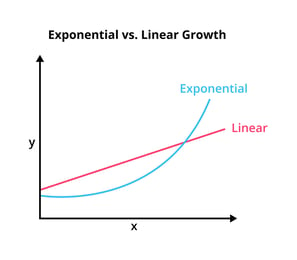Cable | Fiber | Broadband | Wi-Fi | 400G
Is Your Network Ready for a 400G Upgrade? (3 Things to Consider)

Today, every Internet service provider (ISP) is adding customers left and right.
Companies based in rural markets with a low population density are seeing subscribers come out of the woodwork. This surge is fueled by the work-from-home (WFH) economy.
Because of this, Internet demand is driving a need for increased speeds to serve the Zoom culture COVID-19 created, on top of the streaming culture established by Netflix, and driven further by the transition from cable television to over-the-top video, like Apple TV and YouTube TV.

As a result, service providers are upgrading their subscriber infrastructure with fiber to the home to enable greater speeds per subscriber.
If a network is at 50% to 70% of its 100G bandwidth, it’s time to do something about the lack of availability within your network. Service providers will determine the next step is 200G from 100G, but sometimes, it is worth looking at 400G instead.
At this point in the decision-making process, a solution provider like CCI Systems can step in to educate the service provider on 400G—which is a new technology with many unknowns. CCI has a services team with lab-tested, field-validated designs who have performed 50+ dual router deployments with success.
Additionally, CCI can offer a consultative approach to examine past and present bandwidth trends while determining whether 400G makes more sense than a stair-stepping model from 100G to 200G to 400G optics.
It is easy to assume a 400G upgrade will be straightforward, even simple, but if you’re thinking about attempting this upgrade in-house, here are some things to consider. First, know the distance between sites. Second, assess the risk analysis on a single point of failure: single or dual routers. Third, put together an installation and implementation plan to complete your network upgrade.
Determine the Distance Between Locations
Higher bandwidth optics do not go as far as 10G optics. With 400G, even 100G, a service provider must consider the physical distance between sites.
Distance is assessed between those two routers, whether they’re located in neighboring towns, nearby cities, or connecting one neighborhood to another neighborhood across town.
For instance, the distance between two cities might be 30 kilometers, which does not raise any red flags. However, above 40 kilometers between sites may cause a provider to give special consideration to 100G and above.
When addressing these long distances, the need for a source of amplification will present the primary challenges and unseen costs associated with upgrading a 10G link to 400G link.
If distance isn’t an issue, the next areas to investigate are subscriber ports counts, port densities, future growth for the node, and existing bandwidth utilization.
Risk Analysis on a Single Point of Failure
Narrowing down what particular router (chassis) to position in the field will be decided by analyzing subscriber port counts and port densities facing toward the subscriber.
By examining the percentage of bandwidth being used today, a service provider can then make a strategic decision concerning future bandwidth requirements.
A common assumption is 400G will be too expensive. With recent acquisitions in the optics market (including Cisco’s acquisition of Acacia), the price of 200G and 400G continues to decline across all vendors from Juniper to Ciena.

Let’s say a service provider has Cisco ASR 9000 routers, and those routers are interconnected with three or four 10G ports bonded together. Knowing the network cannot support any more 10G ports, it’s natural to think 100G is the next move, but this does not always hold true.
If the links between all routers are under 40 kilometers, 100G is an easy upgrade. But, given the bandwidth growth, is a better long-term consideration to go from 200G to 400G?
Another factor to consider is the amount of fiber you have between the sites to bond multiple 100G links together. What if 400G was only a 30% increase in bandwidth, but it met the growth of your network for many years to come?
How does my company analyze our current network?
- Subscriber Growth: Analyze the annual subscriber growth year-over-year for the life of the company. Give special attention to the influx of WFH end users in 2020-21.
- Network Architecture: Understand the complete network architecture to determine if the existing network can support a 400G upgrade, whether it is to the core or the edge.
- Business Analysis: Based on the subscriber growth of the network, a company can make educated projections for the future based on the expected bandwidth usage of an expanded subscriber base.
This will allow subscriber growth to be maximized within the total addressable market (TAM), thereby increasing profit margins, while staying ahead of the competition.
What equipment does my company need to get this done?
Questions your company and leadership should be asking:
- Would you prefer two individual routers for complete redundancy?
- What is the cost benefit of full redundancy versus locations that may be less critical?
- What type of budget is available for an upgrade?
While 400G upgrades are planned for and built out, this future-looking approach revolves around a customized hardware solution to meet demand and enable success. As all service providers know, no two networks are the same.
Choose Your Solution: Single Router or Dual Routers
Some service providers prefer a big chassis with dual redundant controllers. But there are 1RU routers that are easily deployable at a site. Think two separate, distinct chassis for ultimate redundancy versus a single chassis.
Single Router Solution
Service providers will opt for a single router solution for the convenience it offers and from a fear of a dual router solution. Partly, this fear is based on the unknown of what a dual router solution will entail. It’s logical to think a single router solution is easier.
With dual processors in a single router, it is automatic. When one of the processors goes down, the other processor takes over. With a dual router solution, your technicians will have to do some network engineering and run protocols, and it can be a challenge for some service providers.
The most resilient solution available is dual router design. However, it is not always the easiest solution to implement. In a dual router solution, you can literally turn off one router with zero impact on your network.
Dual Router Solution
The big advantage of a dual router solution is resiliency.
This enables high availability of the network, and oftentimes, it is more cost-effective. It’s common to see two separate routers in one rack unit.
There is nothing more fault-tolerant than two routers doing the same job.
At the end of the day, the reluctance to adopt dual routers comes down to a lack of engineering expertise. Despite the advantages, an engineering hurdle is hard to overcome.
During a transition or upgrade to 400G, consulting with a solution provider who has done this before can help find the right router setup for any network. Plus, your company can get expert advice from experienced engineers.
Find an Expert to Support a 400G Upgrade
Anticipating the next five years of bandwidth demand is a crucial component to expanding a service provider’s subscriber base. This directly influences the necessity of a move from 10G to 100G to 400G sites across an SP’s territory.
By analyzing subscriber growth and bandwidth usage, throwing the data into a graph with an X and Y axis, and determining what your network needs to be prepared for will allow for scalability.
CCI Systems bridges this engineering gap a service provider might not have the resources for or access to. This makes any custom solution achievable, and CCI’s expertise can end up saving your company money with either solution.
Everything your company needs to build or grow an ISP is CCI’s bread and butter because we know the network end-to-end.
Additional questions about 400G solutions? Contact us for a free network planning session to understand options and considerations for your network growth.

